#chrysler museum of art
Explore tagged Tumblr posts
Text

Flowing Icewater, 2024

Melting Glacier III, 2023

Ice Cave, 2023
Works in kiln-cast glass by Peter Bremers at the Chrysler Museum of Art in Norfolk, Virginia.
Despite their apparent delicacy, these pieces are dense and imposing. All are about a meter tall. These and other works by Bremers are on display at the museum through mid-January, 2025.
#photographers on tumblr#art glass#Peter Bremers#Chrysler Museum of Art#Norfolk#Virginia#phone photo
139 notes
·
View notes
Text

Saint Thomas
Artist: El Greco (Greek, 1541-1614)
Date: ca. 1600
Medium: Oil on canvas
Collection: Chrysler Museum of Art, Norfolk, Virginia, United States
Thomas the Apostle
Thomas the Apostle was one of the Twelve Apostles of Jesus according to the New Testament. Thomas is commonly known as "Doubting Thomas" because he initially doubted the resurrection of Jesus Christ when he was told of it (as is related in the Gospel of John); he later confessed his faith ("The lord of me and the God of me") on seeing the places where the wounds appeared still fresh on the holy body of Jesus after the Crucifixion of Jesus.
#portrait#saint thomas#christianity#biblical art#apostle thomas#painting#thomas the apostle#robe#walking stick#oil on canvas#fine art#oil painting#christian art#art and the bible#greek culture#greek art#el greco#european art#17th century painting#doubting thomas#chrysler museum of art
22 notes
·
View notes
Text

Portrait of a Hélène Standish
Artist: Pierre Auguste Cot (French, 1837-1883)
Date: 1879
Medium: Oil on canvas
Collection: Chrysler Museum of Art, Norfolk, Virginia, United States
Description
This is an oil on canvas painting of a Hélène Standish. Her figure stands in profile while her head is turned over her left shoulder. A modest pose, her hands clasped together in front of her. She regards the viewer with a serene expression, a slight blush on her cheeks. Her silvery white gown is ornately decorated with gold and pearls. Stiff lace stands up around her collar and the neckline is decorated with pearls. She wears two rings on her wedding finger and a gold bracelet coiled around her left wrist like a snake. A small feathered ornament rests in her gracefully pulled back hair. The background is painted to resemble a faded red carpet or tapestry.
#portrait#knee length#helene standish#oil on canvas#fine art#oil painting#artwork#clasped hands#silvery white gown#gold lace#pearls#embroidery#pearl necklace#rings#gold braelet#feathered ornament#woman#french culture#french art#pierre auguste cot#french painter#european art#painting#19th century painting#chrysler museum of art
24 notes
·
View notes
Text
t’s #NationalShrimpDay so it’s the perfect excuse to share this 😛

Woman With Shrimp, c.1930s
Ercole Barovier (Italian, 1889-1974) for Barovier & Toso (Italian)
Blown & solid-worked glass
13.5x4.75x7.5 in. (34.3x12.1x19.1 cm)
The Chrysler Museum of Art 97.42.9
#animals in art#animal holiday#european art#20th century art#glass#art glass#figure#figurine#shrimp#crustacean#National Shrimp Day#Chrysler Museum of Art#1930s#Italian art#Ercole Barovier#Barovier & Toso
62 notes
·
View notes
Photo

Finger Drawings Art di Judith Braun https://www.design-miss.com/finger-drawings-art-di-judith-braun/ L’artista di New York Judith Braun crea delle opere d’arte sulle pareti immergendo le mani nella polvere di carbone. Il suo ultimo murale “Diamond Dust”, dipinto presso il Chrysler Museum […]
#Chrysler Museum of Art#coolhunting.com#dipingere#dita#Judith Braun#new york#Norfolk#pareti#video#Virginia
2 notes
·
View notes
Text

Undine Rising from the Fountain (1880–1882) 🎨 Chauncey Bradley Ives 🏛️ Yale University Art Gallery 📍 New Haven, United States
According to medieval lore, undines were Mediterranean sea spirits who lived as soulless mortals. In the nineteenth century, this story gained prominence through Baron Heinrich Karl de la Motte Fouqué’s popular novel Undine, in which a water spirit gains a human form and soul by marrying the mortal knight she loves. When her husband proves unfaithful, the laws of the water spirits force her to kill him. Chauncey Bradley Ives depicts the moment when the mournful Undine, cloaked in a white veil, rises like a fountain to claim her husband’s life. Exquisitely rendered, the diaphanous wet drapery is a masterful example of illusionistic carving.
#Undine Rising from the Fountain#Chauncey Bradley Ives#1880#1881#1882#Chrysler Museum of Art#New Haven#United States#marble#sculpture#american#Mythology#Greek Mythology
6 notes
·
View notes
Text
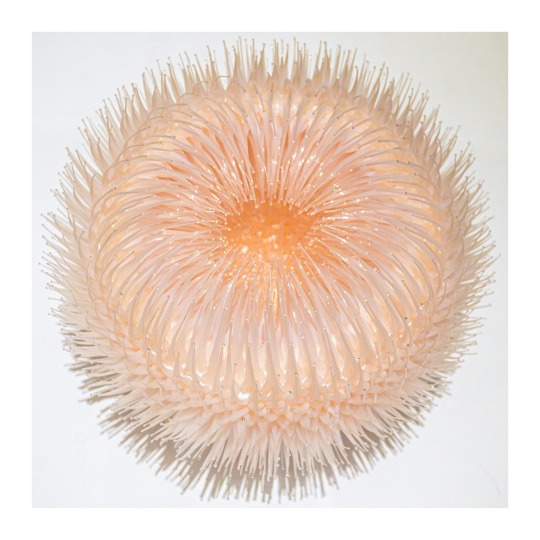
Tactual Stimulation, Dafna Kaffeman, 2007, flameworked glass filaments.
At the Chrysler Museum of Art, Norfolk, Virginia.
481 notes
·
View notes
Text

The Meeting of David and Abigail
Artist: Guido Reni (Italian, 1575-1642)
Date: ca. 1615-1620
Medium: Oil on canvas
Collection: Chrysler Museum of Art, Norfolk, Virginia, United States
Description
In this Old Testament scene, Abigail visits David’s camp to apologize for her husband who had insulted David and his soldiers. Pale and bowed with her eyes downcast, Abigail’s remorse is apparent. Even her donkey droops apologetically. David stands proud in his shiny armor and red flowing cape, but his face suggests tenderness - perhaps alluding to the end of the story when David and Abigail wed after her wicked husband dies.
1 Samuel 25:32–33
And David said to Abigail, “Blessed be the Lord, the God of Israel, who sent you this day to meet me! Blessed be your discretion, and blessed be you, who have kept me this day from bloodguilt and from working salvation with my own hand!
#biblical art#biblical scene#christianity#david#abigail#oil on canvas#book of 1 samuel#oil painting#artwork#fine art#men#women#narrative art#conversation piece#painting#donkey#armour#costume#holy bible#art and the bible#italian culture#italian art#guido reni#italian painter#european art#17th century painting#chrysler museum of art
20 notes
·
View notes
Text

Portrait of Mrs. John Farthing
Artist: Martin Archer Shee (Irish, 1769-1850)
Date: 1800-1899
Medium: Oil on canvas
Collection: Chrysler Museum of Art, Norfolk, Virginia, United States
Description
This is a large oil painting on canvas. Mrs. Farthing is in the center dressed in white fabric as she walks down the steps in gold shoes. There is a slight swirling of her dress about her feet. The red hollyhock of the bottom left foreground points the viewers eye upward to her red necklace, red lips and blushed cheeks. The background is a shadowy outdoor scene framing Mrs. Farthing with trees and their draping leaves. Just behind her head on the right is a touch of the classical in the form of an urn.
#portrait#painting#oil on canvas#full length#mrs. john farthing#fine art#oil painting#artwork#white gown#steps#gold shoes#red hollyhock#red necklace#trees#urn#flower bush#drapery#body of water#female figure#irish culture#irish art#martin archer shee#irish painter#european art#19th century painting#chrysler museum of art
21 notes
·
View notes
Text



Paul McCartney Photographs 1963–64: Eyes of the Storm exhibit, Chrysler Museum of Art, Norfolk, VA
Plus bonus angle from the next room - a glance from across the ages

3 notes
·
View notes
Text





[ID: A series of photographs taken at the Chrysler Museum in Norfolk, VA; they include a close up of tuned glasses with their notes labeled on them in a Harmonicon set; a blue bull's head with "tongue" sticking out which is actually a mustard pot with spoon; two pieces in contrast, one an ancient reclining woman on a sarcophagus, the other a modern sculpture of drapery reclining with no figure inside, made of sandblasted glass; a Frank Lloyd Wright designed window backlit by natural light from a pair of glass doors behind it; and lastly, the sculpture at the front of the museum, looking out over the water, showing a man astride a rearing horse, reaching down to help another man up.]
When I was in Virginia, we wanted to take Toddler U to the Chrysler Museum; I wanted to see it, and R has been taking her to public places to acclimate her to How We Behave in the library or the grocery store or the museum (quiet voices, hands to ourselves, etc). It's a real hidden gem -- I didn't know it existed until R suggested it, despite my deliberately looking in the area for stuff to do. It has a glass studio and a very lovely collection of glassworks, as well as paintings, sculpture, and historical artefacts; we really only got to see the glass gallery, since getting out the door with a two-year-old took some time, but it was worth going just for that, and admission was free. (I did get to peer into the ancient art while R took U to the bathroom.)
I was disappointed that the gift shop didn't have any postcards of any of their glass, which is kind of their pride and joy, but I think perhaps the glass studio has a gift shop and that's where they keep them. In any case, good excuse to go back. :)
R had dressed U in a pink ballerina dress, so she went through the gallery pointing out everything that was "Pink like me!" and then became fascinated by one of the postcards they DID have, which was one of Degas' ballerina paintings. I asked if R had any plans to put her in dance classes since she loves dancing and could use to burn off energy. R, whose grandparents immigrated from Ireland and who took Irish dance as a kid, told me, "Little does she know the Irish Step-Dancing class that awaits her."
117 notes
·
View notes
Text
i'm not a young man anymore on two different nights with the exploding plastic inevitable in provincetown mass sept 1966
couldn't pick one so here's both.. the 2nd is my fave but the 1st is easier on the ears
#this whole recording is such a cool document#u can hear symphony of sound playing between songs & some audio from warhol's films & some of reed & cale's live soundtrack to hedy#&sometimes the journalist recording it describes what's going on- the lights the band the screens etc#plus the 17min interview with john cale tho it's mostly abt the films#&some truly horrendous noises#the source link has audio file urls & setlists#&a link to the Dorothy Gees Seckler Collection of Sound Recordings Relating to Art and Artists 1962-1976 tho u can't listen to anyth there#the velvet underground#nico#i'm not a young man anymore#exploding plastic inevitable#1966#19660900#music#audio#my posts#also john waters was in the audience!#chrysler art museum
3 notes
·
View notes
Text




Chrysler Museum of Art, Norfolk VA
4 notes
·
View notes
Text

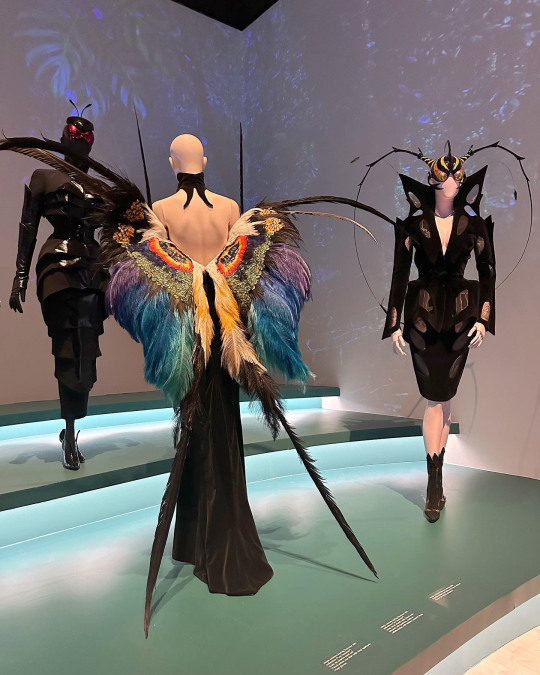

Even if fashion isn’t something you normally find interesting, it’s hard to resist the allure of the creations on view at the Brooklyn Museum for the retrospective Thierry Mugler: Couturissime.
From the museum’s web page-
Thierry Mugler: Couturissime is the first retrospective to explore the fascinating, edgy universe of French designer and creator of iconic perfumes Thierry Mugler. A fashion visionary, Mugler established himself as one of the most daring and innovative designers of the late twentieth century. His bold silhouettes and unorthodox techniques and materials—including glass, Plexiglas, vinyl, latex, and chrome—made their mark on fashion history.
In the 1970s, Mugler defined trends with his acclaimed “glamazon,” a chic, modern woman whose style evolved from the hippie fashions of the 1960s. In the 1980s and ’90s, Mugler galvanized the renaissance of haute couture through his provocative collections and theatrical fashion shows, which involved grandiose locations and the era’s most iconic models. Just as his work is still influencing new generations of couturiers, celebrities continue to be drawn to Mugler’s designs: his classic gowns have recently been worn by Beyoncé, Cardi B, and Kim Kardashian.
The exhibition features over one hundred outfits ranging from haute couture pieces to stage costumes, alongside custom accessories, sketches, videos, images by leading fashion photographers, and spectacular installations that mirror Mugler’s futuristic approach. The Brooklyn Museum’s presentation also introduces an expanded section dedicated to fragrance, centered on Mugler’s trailblazing scent Angel. Thierry Mugler: Couturissime is an opportunity to discover and rediscover the fantastical work of this multidisciplinary artist, who revolutionized the world of fashion.
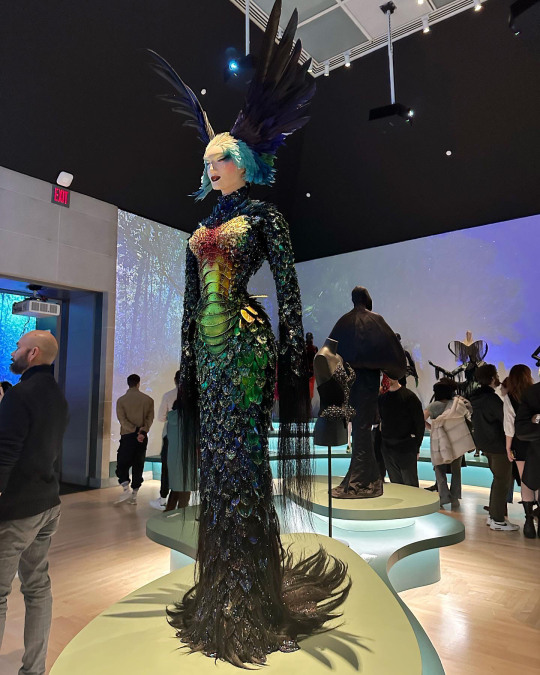
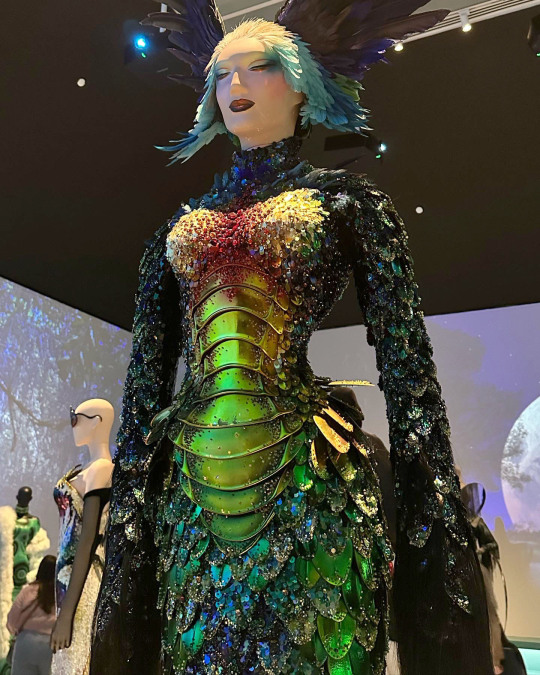
A description of the above gown from the museum’s info plaque-
The “La Chimère” gown-Mugler’s masterpiece made in collaboration with the South African corset maker Mr. Pearl and the artist Jean-Jacques Urcun- has mythical status, considered by some as one of the most expensive creations in couture history, given the meticulous amount of work required in its making.
Mr. Pearl describes that collaboration with Mugler as the most extreme experience of his life: “[‘La Chimère gown] was probably the most intense project, it took six weeks working 24/7, so basically more than one thousand hours just in embroidery. We were about twenty people working on different parts of it along with Jean-Jacques Urcun. It’s about fantasy, it was like going to the University of Beauty. To fulfill his vision and his fantasies with clothes is already a challenge, he is a genius, a perfectionist. You have to try, and he pushes everyone to try what seems impossible to achieve with a needle.”
Also included in the exhibition are several incredible (and often safety-defying) photos Mugler took himself at various landmarks, including the one below at NYC’s Chrysler Building.
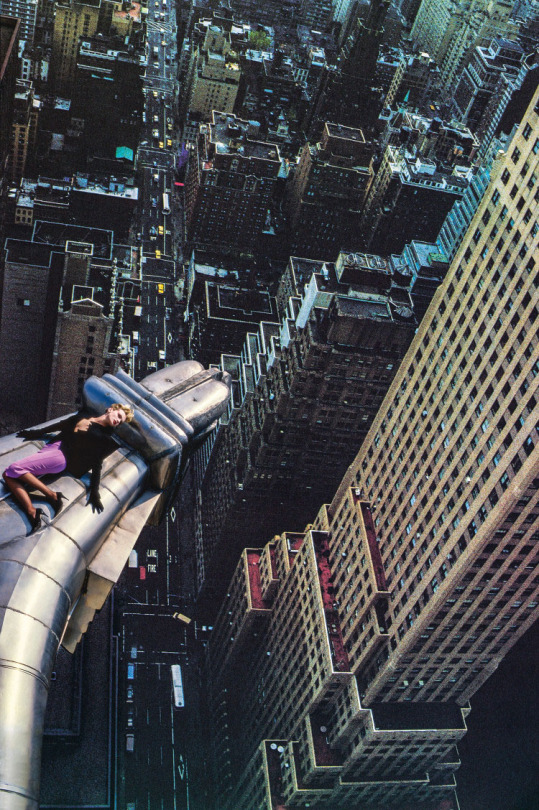
(“Chrysler Building, New York”, 1989 -Claude Heidemeyer in “Vertigo” by Mugler, 1988)
This exhibition closes 5/7/23.
#thierry mugler#brooklyn museum#fashion design#fashion designer#retrospective#art shows#brooklyn art shows#nyc art shows#fashion#art#photography#fashion photography#chrysler building#mr. pearl
11 notes
·
View notes
Text

Untitled.
#photographers on tumblr#Norfolk Keels#Sam Gilliam#Huber Court#Chrysler Museum of Art#Norfolk#Virginia#phone photo
51 notes
·
View notes
